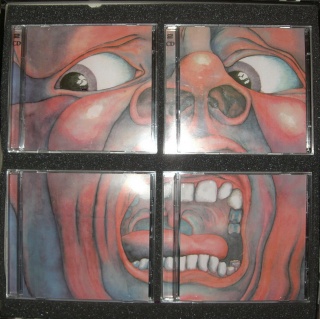
King Crimson – I Talk To The Wind (Studio Run Through)
King Crimson – Epitaph (Backing Track)
This holiday season, musical nerd that I am, I was able to splurge and pick up the 5 CD anniversary edition of a classic LP, King Crimson’s debut from 1969, In The Court of the Crimson King. I first heard King Crimson on a “sick” day from middle school watching MTV’s Closet Classics. They played a live version, probably from Beat Club, of the group performing “Larks Tongues in Aspic” and I was floored, I’d never heard anything so simultaneously beautiful and ferocious, maybe still haven’t. When I started buying cassettes (this was the late 1980s after all), beginning appropriately enough with A Young Person’s Guide To King Crimson and then to the studio releases, I found that there were different versions of the songs, so King Crimson was also my introduction to the “alternate take,” and “alternate mix,” and probably the reason I take such joy from finding subtle differences in different recordings, performances or mixes.
This expanded edition (there are also 2cd versions available) features virtually every possible edition of this album. There’s a new 2009 mix (with a thankfully “edited” version of “Moonchild,” chopping out a full 3 minutes of noodling that I always found incongruent with the mood of the piece), the previously highly touted 2004 mix, a mix from a original pink label Island records 1st pressing (from Fripp’s own private collection no less), a promo mix culled from vinyl for US DJs, single mixes and a slew of unreleased studio and live recordings. It’s a pretty overwhelming batch of tuneage given that the original album only had 5 songs to choose from, but something that is geared towards Crimso-fanaticos only. Personally, I’m a little disappointed that there wasn’t more from the “Morgan Studios” sessions with Tony Clark, from what appears to be the recreated master list from those sessions, it seems the group recorded a version of “Tomorrow’s People,” probably the best track from Crimson off-shoot McDonald & Giles (which I’ll have to feature sometime in 2010). All we have from that session is a blistering instrumental version of “21st Century Schizoid Man,” that makes you wonder what the band heard that made them want to scrap this session and take over production themselves.
Speaking of instrumentals, based on the amount of instrumental “backing” tracks to make it on this set, I’m curious if Fripp is courting producers to sample and remix Crimson’s work. It’s hard not to hear those possibilities on “Epitaph” or “I Talk To The Wind,” especially the studio run-through, with that unique drum sound from Michael Giles. More likely, the inclusion of the many instrumentals were designed to place a focus on the musicianship of the players. Having the instrumental backing track of “21st Century Schozoid Man,” a trio recording featuring Giles, Fripp & Lake, definitely shows how clearly locked in they were even though the group in this incarnation was together for less than a year in total, and had spent even less time together when they began recording. They nailed this backing track on the first take and hearing it this way was a revelation for me, from Fripp’s solos to the fact that Giles was using a double bass drum set, something that at least to my ears was obscured in the final mix.
You also get to feel a bit of the fire that this band produced with the inclusion of live material from Hyde Park and the Fillmore, in addition to a couple of recordings from Peel Sessions the group did. Also included are extensive notes, in some cases from Robert Fripp’s personal journal, on the rise and fall of the band. Those notes helped me to understand better what I had always found to be a strange thing, how Ian McDonald could go from being in King Crimson to Foreigner, but part of the reason that it appears he gave for leaving the band was the “dark” overtones of the music and a personal need to make sunnier music. There’s also an interesting article that connects the business side of Crimson to the larger trends in the music industry. All in all a fine collection and the type of thing that a “40th Anniversary Edition” should be all about.
In listening to this anniversary edition and thinking about the music to follow, it’s interesting to me that for a record that all but ushered in “progressive rock” the music is actually rather pastoral. Really much of that moniker comes down to “21st Century Schizoid Man,” their most well known song and a crazed mixed of rock and avant-garde jazz. “I Talk To The Wind,” “Moonchild,” “Epitaph,” and “In The Court of the Crimson King” sound nothing like that track and had it not been included (an impossibility of course), we’d have a very different impression of the band. There are other records from King Crimson that I enjoy more, or at least that contain more cherished songs for me, but as a total package, it’s hard not to argue that this record is the one that rules them all, the boxed set, simply cements the legend.
